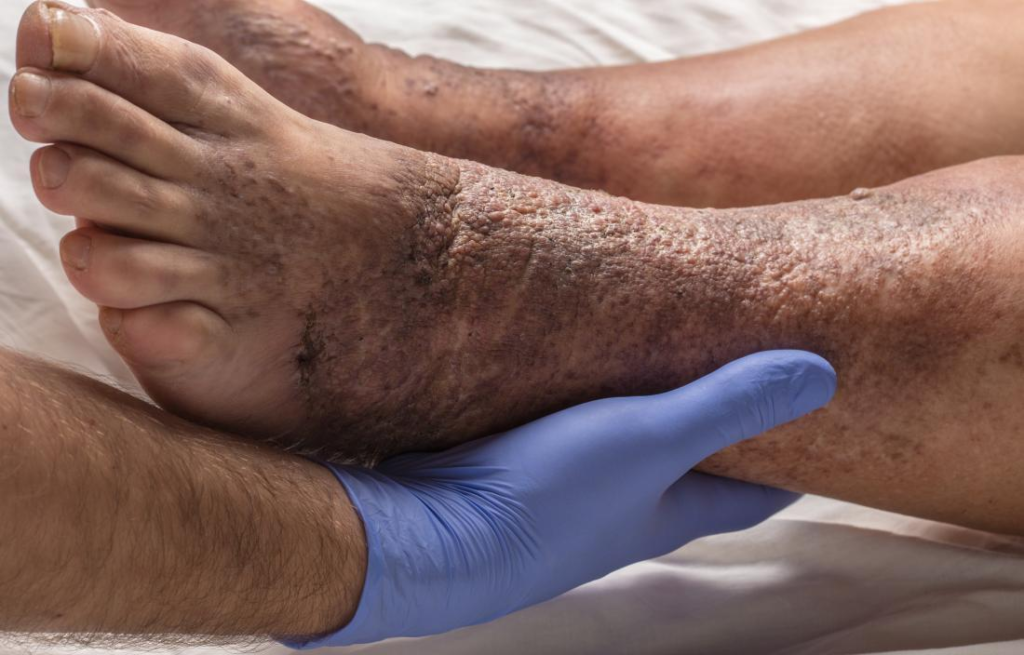In the complex realm of dermatological conditions, Stasis Eczema, also known as Gravitational Dermatitis, emerges as a perplexing disorder primarily affecting the lower extremities. This article dives into the causes and management of Stasis Eczema, offering valuable insights tailored for Canadians. By exploring the symptoms, triggers, treatment options, and lifestyle adjustments, the article provides a comprehensive perspective to help Canadians take proactive steps in managing this condition. Understanding the impact of gravitational forces on skin health empowers individuals across Canada to improve their quality of life and enhance overall skin health.
Understanding Stasis Eczema
Stasis Eczema, alternatively referred to as gravitational dermatitis or eczema stasis, is a type of eczema that emerges as a chronic skin disorder predominantly affecting the lower extremities. The telltale signs include redness, persistent itching, and noticeable scaling of the skin. While these symptoms are unmistakable, understanding the root causes is crucial for devising effective strategies to manage and alleviate the condition.
Why is it Called Gravitational Dermatitis?
The intricate connection between Gravitational Dermatitis and Stasis Eczema lies in the impairment of blood flow. Gravity, a constant force in our lives, can wreak havoc on circulation when hindered. This, in turn, leads to the pooling of blood in the lower limbs, triggering a cascade of events that manifests as Stasis Eczema. Understanding this intricate relationship serves as a cornerstone for effective management and treatment strategies.
Identifying Stasis Eczema Symptoms
Stasis Eczema presents a myriad of symptoms, often affecting the lower extremities. Recognizing these signs is crucial for timely intervention and effective management:
- Persistent Itching: One of the hallmark symptoms of Stasis Eczema is persistent itching, often accompanied by discomfort.
- Red Patches of Skin: Affected areas may exhibit red patches of skin, indicating inflammation and heightened sensitivity.
- Scaling of the Skin: Stasis Eczema can lead to the scaling of the skin, creating a rough and uneven texture.
- Swelling: Individuals with Stasis Eczema may experience swelling in the affected regions, adding to the overall discomfort.

What are Stasis Eczema Triggers?
To effectively manage Stasis Eczema, it’s essential to identify and address triggers that can exacerbate the condition. In Canada, where diverse climates and lifestyle habits can influence skin health, understanding these triggers is key:
- Prolonged Periods of Standing or Sitting: Extended periods of immobility can impede blood circulation, exacerbating Stasis Eczema symptoms.
- Tight Clothing Choices: Wearing tight clothing can limit blood flow, causing blood to gather in the lower limbs.
- Environmental Factors: Harsh Canadian winters and dry indoor heating can trigger or worsen Stasis Eczema. Extreme temperatures and low humidity are common contributors that exacerbate skin conditions.
- Obesity: Excess weight can strain the circulatory system, amplifying the risk of developing Stasis Eczema.
- Association with Gravitational Dermatitis: Gravitational forces play a significant role in triggering Stasis Eczema. Understanding and mitigating the impact of gravitational forces is paramount for effective management.
Stasis Eczema Treatment Options
Effectively managing Stasis Eczema requires a multifaceted approach that addresses both symptoms and underlying causes. Understanding the connection between Stasis Eczema and Gravitational Dermatitis is pivotal in devising comprehensive treatment strategies:
- Topical Steroids: Dermatologists often prescribe topical steroids to reduce inflammation and alleviate itching associated with Stasis Eczema.
- Emollients and Moisturizers: Regular application of emollients and moisturizers helps maintain skin hydration, reducing the risk of flare-ups.
- Compression Therapy: Compression stockings or bandages can aid in improving blood circulation and mitigating the impact of gravitational forces on the lower limbs.
- Elevating Legs: Elevating the legs when resting can assist in minimizing swelling and promoting better blood flow, addressing the gravitational aspect of Stasis Eczema.
- Avoiding Triggers: Identifying and avoiding triggers, such as prolonged periods of standing or sitting, is crucial in preventing exacerbation of symptoms.
- Weight Management: For individuals with obesity-related Stasis Eczema, weight management becomes an integral part of the treatment plan, addressing gravitational factors.

Regularly moisturizing skin can reduce the risk of Stasis Eczema flare-ups.
Understanding that Stasis Eczema is not isolated but interconnected with gravitational dermatitis allows for a more nuanced and effective treatment strategy, improving the overall quality of life for individuals dealing with this chronic skin condition.
Seeking Professional Help
In an era defined by digital connectivity, accessing medical expertise has become more convenient than ever. An Online Eczema Dermatologist can offer valuable insights and guidance for individuals grappling with Stasis Eczema. Their specialized expertise ensures a tailored approach to treatment, considering the unique aspects of each case. For those dealing with persistent symptoms, reaching out to an online dermatologist specializing in eczema and contact dermatitis can be a transformative step toward skin health.
Lifestyle Adjustments for Stasis Eczema Management
Understanding that managing Stasis Eczema extends beyond medical interventions, incorporating lifestyle adjustments is key to achieving long-term relief. By making conscious choices in daily habits, individuals can positively impact their skin health and minimize the impact of Stasis Eczema symptoms. Here are essential lifestyle adjustments to consider:
Embracing Moisturization
Dry, irritated skin is a hallmark of eczema, and this is especially prevalent during Canada’s harsh winters. Regular and thorough moisturization is essential for managing Stasis Eczema symptoms. Opt for fragrance-free, hypoallergenic moisturizers to soothe and hydrate the skin, providing much-needed relief. In dry climates or heated indoor spaces, it’s especially important to moisturize frequently to keep the skin barrier intact.
Mindful Clothing Choices
In Canada’s variable climate, the choice of clothing plays a significant role in eczema management. Wearing loose, breathable fabrics can help prevent further irritation, particularly during fluctuating temperatures. Tight clothing, common in colder months for warmth, can restrict blood flow and exacerbate Stasis Eczema symptoms. By opting for comfortable, non-restrictive clothing, Canadians can reduce the pressure on their lower extremities, supporting better skin health and reducing flare-ups.
Final Thoughts
In conclusion, understanding Stasis Eczema and its connection to Gravitational Dermatitis helps Canadians manage this complex skin condition more effectively. By exploring its symptoms, triggers, treatment options, and key lifestyle adjustments—such as regular moisturization, mindful clothing choices, and consulting online eczema dermatologists—individuals can take a comprehensive approach to care. Recognizing the impact of gravitational forces on skin health emphasizes the need for tailored strategies, empowering Canadians to improve their skin health and quality of life through proactive management.
FAQs
Can Stasis Eczema affect areas other than the lower extremities?
Yes, while Stasis Eczema predominantly affects the lower limbs, it can occasionally manifest in other areas, emphasizing the need for vigilance and early intervention to address its diverse presentations.
How does gravitational dermatitis impact individuals with existing skin conditions beyond eczema stasis?
Gravitational dermatitis, while linked to Stasis Eczema, can exacerbate other pre-existing skin conditions due to impaired blood circulation, emphasizing the importance of a comprehensive approach in managing dermatological concerns.
Are there specific dietary considerations that can contribute to or alleviate symptoms of Stasis Eczema?
While dietary factors are not extensively covered in the article, some individuals find relief by incorporating anti-inflammatory foods into their diet, potentially aiding in managing Stasis Eczema symptoms alongside traditional treatments.
Can Stasis Eczema be aggravated by stress or emotional factors?
While not explicitly discussed, stress can contribute to inflammatory skin conditions, and individuals with Stasis Eczema may experience worsening symptoms during periods of heightened stress, highlighting the importance of holistic approaches in managing this dermatological concern.
